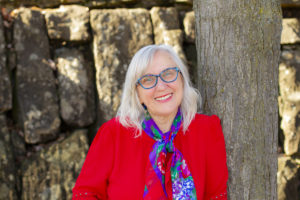Today on Skiffy and Fanty, The Gossamer Mage author Julie Czenerda talks about flipping between SF and Fantasy in her writing.

The Gossamer Mage is my 20th novel (all published by DAW Books, to my pride and joy). Among them, Mage is an odd duck. After all, the vast majority of my work, 17 of those novels, is science fiction. The other two exceptions are fantasy, but as one is a sequel to the other, it’s appropriate to say I’ve only flipped from science fiction twice. To flip back again, of course. As Mage hits stores, I’ll be writing the next Esen book, Mirage.
So what’s it like, going from one to the other?
Like moving to a new home, something we done a fair bit in the last few years.
Thus flipping genre, for me, starts with a moving date. In writerly terms, the day I must commit to writing the “other” thing. Because I do need to commit.
Say the date will be July 31st. I’ve been writing fantasy steadily since I stopped writing science fiction, May 4th, 2018. First Mage, then the special enovella set in my Night’s Edge series, “A Dragon for William,” and feel free to ask me about switching between worlds and voice and magic systems in fantasy sometime because that’s another whole package of brain twist.
By July 31st I need to be packed up and ready to leave fantasy. There’s the bittersweet of leaving a place that’s become home. That I know. That’s a comfort. There’s the anxiety of envisioning what right now, to my entrenched in fantasy brain, seems a very new and strange place, science fiction, though I’ll have Esen with me for much of that. Nothing wrong with a favourite character, by the way. When I’m making this scale of move, it’s nice to know an old friend will be waiting. Still, there’s work to be done.
A Turn of Light, my first fantasy novel, taught me what that work is. For me. Every writer has their approach. I’m well aware not everyone separates their genres as much as I do, or even at all. My preference is simply that the fantasy (and science fiction) I most enjoy reading are distinct from one another, therefore what I enjoy writing is too.
More importantly? I’m a scientist by inclination and education. Science fiction is my regular beat. What I write follows directly from what I know, what I can learn, and what twigs my curiosity into speculation. It’s fun and wonder-filled, but to write fantasy, my kind of fantasy, I can’t be a scientist. I have to unleash something else inside my head. The part that is willing to overturn what is real or someday/somewhere could be, able to create without fear or second-guessing, above all to lose the compulsion to justify my story choices.
That me, by the way, loves the strangest places. That me would happily live in a bubble and forget how to cook. That me is hilarious.
Moving there? For Turn, I stripped my office, literally packing away my science reference books, biology samples, etc, then covered walls with fabric. I started writing by candlelight, though before I wrote the first word, I took 28 days to build the world from polystyrene. [Editor Note: Reader, I’ve seen this in person, it’s glorious] . My process was different too. I’d write 40 thousand words, then delete them, because they contained a hint of justification. Because they weren’t free enough. Because they didn’t have any…deliciousness…to them. (My fantasy writerself turned out to be persnickety and critiqued in such terms.) Writing the sequel, A Play of Shadow, was easy, being still in that mindset and now surrounded by judgemental toads. How easy? Turn took me two and a half years to complete, Play? Under 6 months.
Moving back to science fiction? I’d some concern, especially when a friend asked me to submit a short SF story before Play was released. Hmmm.
I was curious about the social impacts of genetic engineering—curiosity never stops, you know, even when in fantasy writerself. Before I’d noticed, I’d written “A Taste for Murder,” a detective noire murder mystery around DIY genetic enhancement, which came out in Solaris 3 edited by Ian Whates.
Look at that. Moving from fantasy to science fiction? Like snapping a stretched rubber band. Good thing, as I’d a trilogy to write next, Reunification. Oh, and the new Esen novel, Search Image. Let’s not forget more shorts and The Clan Chronicles: Tales from Plexis.
I did pack up the accoutrements of fantasy. Toads and dragons went to high shelves or into boxes (we did keep moving). I returned to walls of post-it notes and organization, with occasional fossil. Though, interestingly, I found myself deleting more words than I had before. One does learn.
When you move, though, there’s a period of being not so much homesick as not ready to say “this is where I’m from, now.” For physical moves, I need two years. The first to experience the new through the four seasons; the second when I anticipate what’s coming. Don’t get me wrong, I loved writing the climax to Sira and Morgan’s story, and Esen? I’d been away far too long away her cheerful compassionate fumbles and all that weird biology. Slime!
Yet…that other me, the one I’d set free to write fantasy. That me was twitchy. Fortunately, I’d Mage waiting.
Did I remember how, though? Was remembering—using the tricks from before—even going to help me? Because this wasn’t the same kind of fantasy. This wasn’t to be a warm cocoa and snuggly spot book, like Turn. The Gossamer Mage was curious-me, questioning fantasy itself. Why was fantasy different—why was I different writing it?
What did I want from magic?
Rather than worry if I could do this, I moved. As I had for Turn, I delayed writing the first word. Not to build a model, alas; I’d planned to do another but I’d run out of time. Instead, Roger and I went hunting for pens. Specifically 18th century dip pens, like those used by the mages in the story. We scoured odd little flea markets and glossy antique stores. He found me an antique inkpot. I found a modern beautiful glass pen.
And yes, I rearranged my office. Dragons returned to my desk. Throughout the house, in fact. May 4th, 2018, I officially moved back to fantasy and began to write Mage.
Forget the rubber band.
This time?
I’d found I had wings. The story grabbed me by the neck—at least that’s how it felt—demanding every moment I could give it. Awake or asleep. I’d fuss and work to get one word just right, then out would pour the next thousand without pause or need to edit. Repeat. It was breathtaking. I’d sob while writing and whenever I reread, drenching my poor abused keyboard and making dreadful blubbery snorts. Roger, whose office is next door, didn’t mind the snorts as much as when I cheerfully cranked the theme from Pacific Rim to the max for the happy bits.
What an interesting place to find myself.
I’m closing in on science fiction again, excited to write about aliens and biology. Part of me isn’t sure if this is where I’m from, yet, but we’ve come to an agreement, fantasy and me.
I’ll be back.
What is magic? As imagined by Julie E. Czerneda, it’s wild and free, a force of nature and source of
wonder. She first explored this theme in her Night’s Edge series, starting with the award-winning Turn of
Light. In The Gossamer Mage, Julie goes further, envisioning magic not only as integral to landscape and
history, but well aware what we’re doing with it. That tie between us and other, the profound changes we
make by connecting, have always informed her work, be it fantasy or science fiction.
Mage is Julie’s twentieth novel published by DAW Books, and she couldn’t be more proud to belong to
this esteemed publishing family. For more about Julie and her work, please visit czerneda.com.
To celebrate the publication of Gossamer Mage, Penguin Randomhouse books is hosting a giveaway here








